Comet for Windows Tutorial
|
Japanese version Home page |
Updated on November 27, 2004 |
![]()
|
Japanese version Home page |
Updated on November 27, 2004 |
![]()
Comet for Windows can calculate the apparent length and direction of the ion tail.
Please launch Comet for Windows, and select "Menu" - "Ephemeris" menu.
First of all, please select "View" - "Setting" menu, and "View Setting" dialog appears. Then, please check "Tail Length and Position Angle" check box, and input the actual length of the tail in astronomical unit.
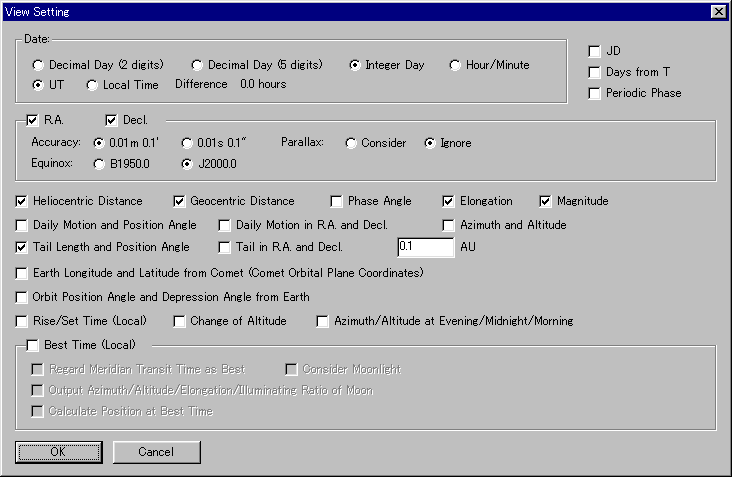
For example, the ephemeris of Comet LINEAR (C/2002 T7), naked-eye bright comet in the Southern Hemisphere in 2004 spring, becomes as follows.
C/2002 T7 ( LINEAR )
Date R.A. Decl. r d Elong m1 Tail(') p.a.
2004- 4-20 23 52.61 4 39.0 0.618 1.218 30 4.3 221.5 255.1
2004- 4-25 23 55.70 3 3.7 0.616 1.041 34 4.1 298.2 251.2
2004- 4-30 0 3.61 1 5.3 0.633 0.853 38 3.9 394.0 247.4
2004- 5- 5 0 20.43 -1 34.2 0.667 0.661 40 3.7 521.9 242.6
2004- 5-10 0 55.83 -5 40.1 0.716 0.476 40 3.5 709.7 233.9
2004- 5-15 2 16.52 -12 42.8 0.774 0.323 36 3.2 994.3 209.6
2004- 5-20 5 2.45 -19 57.4 0.840 0.267 43 3.1 1291.0 154.4
2004- 5-25 7 33.48 -17 43.8 0.911 0.355 63 3.2 966.6 125.4
2004- 5-30 8 44.10 -13 50.3 0.985 0.515 72 4.0 621.8 118.8
|
The position angle of the tail in the ephemeris shows that the ion tail extends towards west in April, but the direction changes rapidly in mid May, then it comes to extend towards east at the end of May.
The ephemeris also shows that the ion tail becomes longest apparently around May 20 when the comet becomes closest to the earth. The apparent length is so long as 1291 arcmin (21.5 degree) even if the actual length is only 0.1 AU. Therefore, it suggests that we can see the very long tail of several dozens of degree.
The dust tail of a comet spreads along the orbital plane of the comet. Therefore, the tail looks more dense and longer when the earth passes cross the orbital plane of the comet, because we come to gaze the flat tail horizontally at that time.
If the orbits of the earth and the comet are almost horizontal, it keeps easy for a long time to see the tail. If the orbits are almost vertical, the tail becomes longer rapidly just before passing cross the orbital plane, and the tail soon becomes hard to see after passing.
Comet for Windows can calculate the best time to see the tail.
Please launch Comet for Windows, and select "Menu" - "Ephemeris" menu.
First of all, please select "View" - "Setting" menu, and "View Setting" dialog appears. Then, please check "Earth Longitude and Latitude from Comet (Comet Orbital Plane Coordinates)" check box.
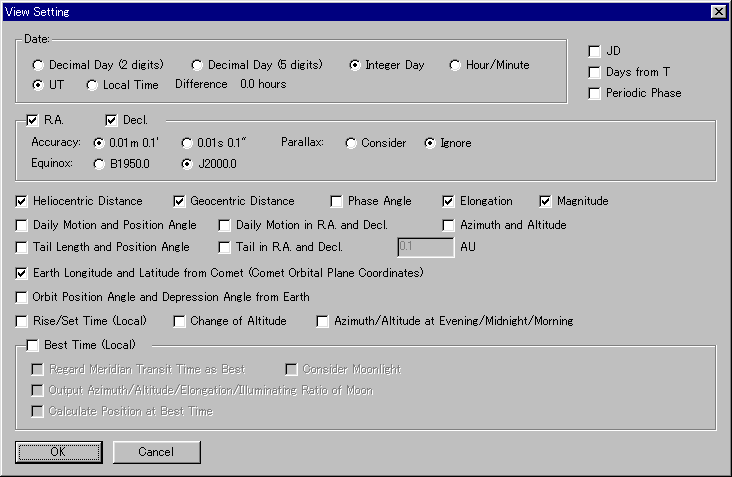
When the earth latitude from comet becomes 0 degree, the earth passes cross the orbital plane of the comet. The tail is easy to see when the earth latitude is near by 0 degree.
For example, the ephemeris of Comet Bradfield, the long tail was observed in the morning sky in late April in 2004, becomes as follows.
C/2004 F4 ( Bradfield )
Date R.A. Decl. r d Elong m1 Earth Dir.
2004- 4-15 1 59.89 1 55.3 0.189 0.922 10 2.3 (248, 16)
2004- 4-20 1 24.37 14 20.4 0.206 0.835 7 2.4 (143, 13)
2004- 4-25 1 3.78 25 38.9 0.346 0.934 20 4.3 ( 91, 7)
2004- 4-30 0 58.59 32 30.4 0.491 1.061 27 5.7 ( 70, 2)
2004- 5- 5 0 59.34 37 9.3 0.627 1.183 32 6.7 ( 58, -1)
2004- 5-10 1 2.50 40 39.1 0.754 1.295 35 7.5 ( 50, -4)
2004- 5-15 1 6.63 43 28.6 0.874 1.397 38 8.8 ( 45, -7)
2004- 5-20 1 11.04 45 52.7 0.988 1.490 41 9.8 ( 41, -9)
2004- 5-25 1 15.36 47 59.6 1.097 1.574 43 10.6 ( 38,-12)
2004- 5-30 1 19.37 49 54.4 1.202 1.650 46 11.4 ( 35,-13)
|
The "Earth Dir." shows the earth longitude and latitude from comet. The origin is the direction of the sun from the comet.
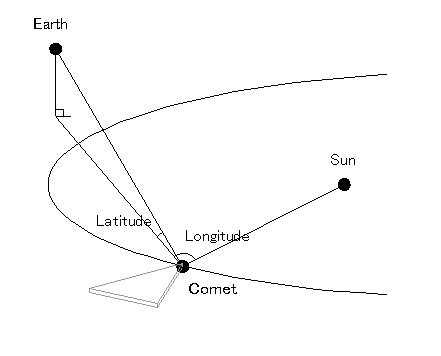
We can see that the earth passed cross the orbital plane of Comet Bradfield when it appeared in the morning sky, and it was the best time to see the tail at that time.
Another example, the ephemeris of Comet LINEAR (C/2001 K5), the long tail had been observed for a long time, becomes as follows.
C/2001 K5 ( LINEAR )
Date R.A. Decl. r d Elong m1 Earth Dir.
2003- 1- 1 17 48.40 21 59.8 5.220 5.841 47 14.8 (355, 6)
2003- 2- 1 18 17.93 26 19.3 5.253 5.705 58 14.8 (359, 9)
2003- 3- 1 18 41.47 31 39.8 5.291 5.541 70 14.8 ( 3, 9)
2003- 4- 1 19 0.45 38 43.7 5.342 5.366 83 14.8 ( 7, 7)
2003- 5- 1 19 7.73 45 50.4 5.401 5.251 93 14.9 ( 10, 3)
2003- 6- 1 19 0.27 52 6.2 5.470 5.214 99 15.0 ( 10, -2)
2003- 7- 1 18 40.23 55 45.7 5.546 5.260 101 15.1 ( 7, -6)
2003- 8- 1 18 17.84 56 25.9 5.631 5.376 99 15.3 ( 2, -9)
2003- 9- 1 18 8.01 54 40.3 5.724 5.539 95 15.5 (357, -9)
2003-10- 1 18 15.35 52 1.0 5.821 5.726 90 15.8 (353, -7)
2003-11- 1 18 37.78 49 30.6 5.928 5.936 84 16.0 (350, -3)
2003-12- 1 19 9.41 48 3.6 6.037 6.151 78 16.2 (350, 1)
|
The earth latitude from comet had been near by 0 degree for a long time. The orbits of this comet and the earth are almost vertical. But actually, it had been easy to see the tail for a long time.
There are many dusts exploded from the comet along the orbit of a short periodic comet. They are called a dust trail. When the dust trail collides with the earth, the dusts fall into the air and become meteors, then we can see the meteor shower.
Comet for Windows can calculate the apparent direction of the dust trail, and calculate the best time to see the dust trail.
Please launch Comet for Windows, and select "Menu" - "Ephemeris" menu.
First of all, please select "View" - "Setting" menu, and "View Setting" dialog appears. Then, please check "Orbit Position Angle and Depression Angle from Earth" check box.
When calculating about the dust trail, we should also calculate the tail. So please also check "Tail Length and Position Angle" and "Earth Longitude and Latitude from Comet (Comet Orbital Plane Coordinates)" check boxes.
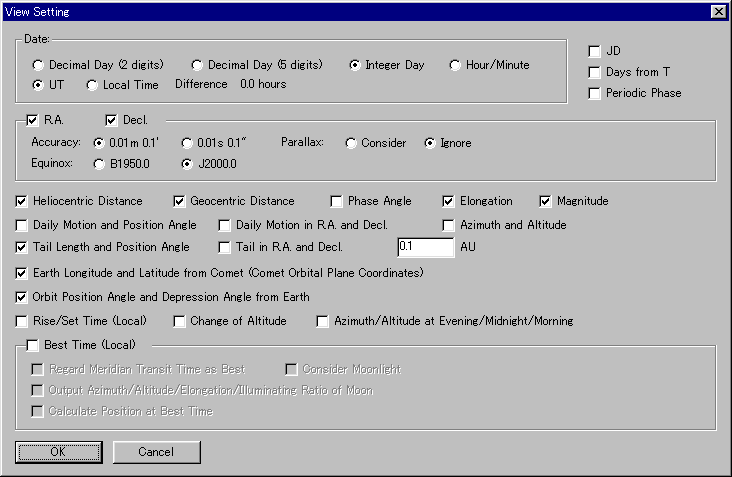
For example, the ephemeris of Comet Gunn, bright short periodic comet in 2003 whose dust trail was detected on the ground, becomes as follows.
65P/Gunn
Date R.A. Decl. r d Elong m1 Tail(') p.a. Earth Dir. Orb(pa,da)
2003- 4- 1 18 28.84 -24 9.3 2.459 2.174 94 13.2 61.5 267.2 ( 23, -4) ( 97, 69)
2003- 4-11 18 40.32 -24 40.9 2.453 2.049 101 13.0 64.3 266.3 ( 23, -3) ( 96, 68)
2003- 4-21 18 49.87 -25 16.7 2.449 1.928 109 12.9 65.9 265.9 ( 22, -3) ( 95, 68)
2003- 5- 1 18 57.16 -25 58.5 2.447 1.815 117 12.8 65.9 266.0 ( 21, -2) ( 94, 69)
2003- 5-11 19 1.86 -26 48.0 2.446 1.712 125 12.6 63.6 266.9 ( 19, -1) ( 93, 70)
2003- 5-21 19 3.74 -27 45.4 2.447 1.623 135 12.5 58.3 268.9 ( 16, -0) ( 92, 72)
2003- 5-31 19 2.67 -28 49.7 2.449 1.549 144 12.4 49.7 272.6 ( 13, 0) ( 92, 74)
2003- 6-10 18 58.76 -29 57.7 2.453 1.495 154 12.3 37.9 279.8 ( 10, 1) ( 92, 77)
2003- 6-20 18 52.51 -31 4.4 2.458 1.463 164 12.3 24.1 296.1 ( 5, 2) ( 93, 81)
2003- 6-30 18 44.75 -32 4.1 2.465 1.456 170 12.3 14.5 344.2 ( 1, 3) ( 94, 85)
2003- 7-10 18 36.69 -32 52.0 2.473 1.473 166 12.4 21.0 41.2 (356, 4) ( 95, 89)
2003- 7-20 18 29.57 -33 25.7 2.483 1.515 157 12.4 33.9 61.9 (352, 5) ( 96, 92)
2003- 7-30 18 24.44 -33 45.5 2.494 1.579 147 12.6 45.2 70.9 (348, 5) ( 97, 95)
2003- 8- 9 18 22.03 -33 53.2 2.507 1.663 137 12.7 53.3 76.0 (345, 5) ( 98, 98)
2003- 8-19 18 22.61 -33 51.6 2.521 1.764 128 12.9 58.2 79.3 (342, 5) ( 98,100)
2003- 8-29 18 26.16 -33 42.8 2.536 1.879 119 13.0 60.2 81.3 (340, 5) ( 97,101)
2003- 9- 8 18 32.47 -33 28.1 2.553 2.004 111 13.2 60.2 82.6 (339, 5) ( 97,102)
2003- 9-18 18 41.20 -33 8.4 2.571 2.137 103 13.4 58.5 83.4 (338, 4) ( 96,103)
2003- 9-28 18 51.99 -32 43.6 2.590 2.276 96 13.5 55.8 83.7 (337, 4) ( 94,102)
|
The "Orb(pa,da)" shows the position angle and depression angle of the comet's orbit.
The first "pa" shows the apparent position angle. The dust trail looks extending towards this direction in the photos.
The second "da" shows the depression angle, which is the the angle between the view direction from the earth to the comet and the direction of comets's motion. When the depression angle is 0 degree, the comet is going away from the earth directly. When the depression angle is 180 degree, the comet is coming towards the earth directly.
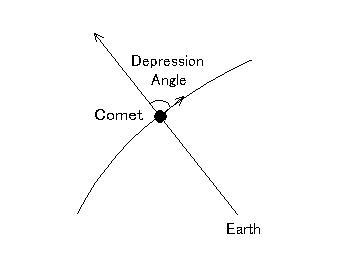
When the position angle of the dust trail coincides with the position angle of the tail, the dust trail overlaps the tail, and cannot be distinguish them. When the depression angle of the dust trail is about 0 or 180 degree, the dust trail overlaps the coma, and cannot be distinguish them. The dust trails cannot be observed at these times.
The apparent direction of Comet Gunn's dust trail coincides with the tail from April to mid June, so the dust trail cannot be observed at that time. However, the apparent direction of the tail begins to change after mid June, then the dust trail can be distinguished from the tail.
The depression angle of the orbit keeps around 90 degree all though the period. That means we keep to observe the dust trail from the side. It suggests that the dust trail looks long, but faint because the dusts become sparse.
In the case of an extinct comet, it is possible to see the dust trail even when the depression angle is about 0 or 180 degree, because the comet has no coma. When the depression angle is about 0 or 180 degree, the dust trail does not look long, but bright because the dusts become dense. So it may be easier to see the dust trail on the contrary.
The following page introduces the calculation about Phaethon, a source of Geminids meteor shower.
Observation Proposal of Dust Trail of a Dead Comet Phaethon = Source of Geminids Meteor Shower!
![]()